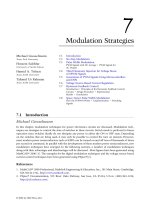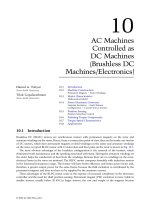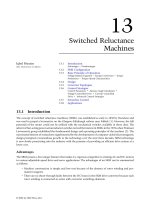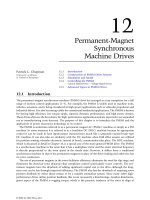Power Electronic Handbook P16
Bạn đang xem bản rút gọn của tài liệu. Xem và tải ngay bản đầy đủ của tài liệu tại đây (712.84 KB, 10 trang )
© 2002 by CRC Press LLC
16
Uninterruptible
Power Supplies
16.1 UPS Functions
Power Conditioning • System Integration
16.2 Static UPS Topologies
Double-Conversion UPS • Line-Interactive UPS • Standby
Power Supplies
16.3 The Rotary UPS
16.4 Alternate AC and DC Sources
Batteries • DC Generators • Superconducting Magnetic
Energy Storage • AC Generators
With the proliferation of electronic loads such as computers, the incidence of power quality-related
problems is growing. As a result, the uninterruptible power supply (UPS) market has grown significantly
in the last few years. What follows is an overview of UPS functions and descriptions of common types
of UPSs and backup power sources.
16.1 UPS Functions
The primary purpose of a UPS is to provide conditioned, continuous power to its load. Another UPS
function that is of growing importance in today’s market is system integration, or the ability to commu-
nicate over a network to facilitate the monitoring and orderly shutdown of loads.
Power Conditioning
A UPS provides continuous, regulated power to its load, under all conditions of the utility power line.
Unlike other types of power conditioning equipment, a UPS provides power during outages. Typically,
a UPS will provide backup power for 10 or 15 min, although longer times are possible with large battery
strings or a DC generator.
A UPS will also correct for high- and low-voltage events, known as surges and sags. This regulation
is provided either electronically or by a tapped transformer or a ferroresonant transformer.
Normal mode, or line-to-line, transients are prevented from reaching the load. This is accomplished
either with filter components, or in a double conversion UPS, by converting the AC to DC and then back
to AC. There is quite some variation in the ability of UPS systems to protect the load from common
mode, or line-to-ground, transients. Safety agency requirements preclude most forms of common mode
transient protection. The best common mode transient suppression is achieved with an isolation trans-
former. Some UPSs have isolation transformers and some do not.
Laura Steffek
Best Power
John Hecklesmiller
Best Power
Dave Layden
Best Power
Brian Young
Best Power
© 2002 by CRC Press LLC
System Integration
The industrial electronics environment is very similar to the typical office LAN/WAN environment when
it comes to using a UPS to provide power protection for industrial-grade PCs, PLCs and other equipment
that make use of any form of microprocessor control.
The fact that a UPS only provides a finite amount of battery backup during an extended power outage
should encourage us to take certain precautions to prevent the corruption and loss of data once the UPS
reaches a point where it can no longer support the load equipment.
Certain methods may be used to communicate to the load equipment when a power outage has occurred
and, in extreme cases, when a low battery condition exists. The load equipment should be configured to
react to critical UPS conditions by saving data and preparing the system for a safe shutdown. Creating
this “communication” between UPS and the load equipment is called UPS integration. There are several
ways that the UPS can be integrated. These methods may be classified into three integration categories:
Basic
Enhanced
Network
No matter what integration methodology is utilized, four items are required to integrate the UPS.
First, the UPS must have a communication port. Second, the equipment being protected must also have
a communication port. Third, some medium (cabling) must be used to connect the two together. Finally,
some form of software must be used to monitor the UPS and provide the appropriate actions relevant
to specific UPS conditions.
Basic
The first and most common integration method communicates the status of the UPS via contact closures.
Typically, normally open or normally closed relay contacts are used to signal two UPS conditions to the
load equipment. These conditions are “AC Failure” and “Low Battery.” An “AC Failure” should be signaled
by the UPS whenever a power failure condition exists for more than 5 sec. The “Low Battery” signal exists
when a minimum of 2 min of battery runtime remains to support the load. However, most UPS manu-
facturers allow this setpoint to be programmed by the user to allow more time to shutdown the system.
In most cases, the software to monitor the UPS is provided as a part of the computer’s operating
system. The UPS manufacturer typically provides the cable and appropriate setup information required
to connect the two together.
Note that UPS manufacturers often substitute open-collector type circuits in place of actual relays, to
provide the UPS signals. Users should pay close attention to this detail if they choose to build their own
interface cable, since current is only allowed to pass in one direction through an open-collector circuit.
Enhanced
To provide more than just the basic UPS status information, many UPS manufacturers have chosen to
offer RS232 and other forms of serial communication that allow real-time UPS data to be monitored by
software running on the load equipment. Instead of knowing only that a power failure has occurred or
that a low battery condition exists, the user may now know how much calculated runtime is available
and the measured battery voltage at any given time. Other data values are typically available that represent
the input and output voltage, percent of full load, UPS temperature, as well as many others.
Since the way this UPS data is presented is usually proprietary, the UPS manufacturer most often
supplies the software to run on the protected load. Because the software is capable of monitoring real
time data from the UPS, a GUI (graphical user interface) is typically used to portray the data using easy-
to-read digital displays and historical graphs.
Network
The size and complexity of today’s local and wide area networks has led to an increase in the use of
network management tools to monitor and control network devices. The Simple Network Management
Protocol (SNMP) has become the de facto standard for network management and is backed by many
© 2002 by CRC Press LLC
network management software products including SunNet Manager, HP-Open View, IBM’s Netview/6000,
and Novell’s NMS.
Today, many UPS manufacturers offer software or a software/hardware combination that effectively
makes the UPS a network peripheral. In some cases an internal or external network adapter is provided
that through its own microprocessor and associated components effectively translates proprietary UPS
data and commands into a format that is compatible with the SNMP standards set forth by a working
group of the Internet Engineering Task Force (IETF). This group recently adopted a standard database
of UPS-related information, called a Management Information Base (MIB), for all UPS products. The
official IETF document that describes this MIB is RFC-1628, which is available on the Internet.
The SNMP-capable UPS provides three basic functions when communicating with a network man-
agement station. It responds to “get” requests by replying back to the management console with a
value corresponding to the requested MIB variable. It responds to “set” requests by allowing the UPS
configuration to be changed by the management console. And it broadcasts unsolicited alarm “traps”
to the network management console alerting the network administrator to the existence of potential
power problems.
The UPS in an industrial environment presents a new challenge to the integrator due to the existence
of many different industrial network protocols. In some cases, many of the same protocols exist that
are present in the office LAN environment, but they are often joined by such protocols as SP50 and
PROFIBus, which are adaptations of Field Bus. Other industrial control protocols include FIP (Factory
Instrumentation Protocol), MAP (Manufacturing Automation Protocol), and Echelon’s LonTalk. UPS
manufacturers have not yet built in direct connections to these industrial networks. In some cases,
protocol adapters are available that translate the RS232 information from the UPS into the required
network protocol. Future developments from UPS vendors may enhance and simplify the UPS connec-
tivity in the industrial environment.
16.2 Static UPS Topologies
A static UPS is one that relies on power electronics, rather than a motor generator, to provide power to
the load. Most UPSs today are of this type.
There are several basic UPS topologies, each of which has its advantages and disadvantages. The terms
“on-line UPS” and “off-line UPS” have commonly been used to describe some UPS topologies. Unfor-
tunately, UPS manufacturers have not been able to agree on the meanings of these terms, leading to
confusion among users. Terms which are more descriptive of the differences between various topologies
are double-conversion UPS, line-interactive UPS, and standby power supply.
Double-Conversion UPS
A double-conversion UPS (Fig. 16.1) first rectifies incoming AC line to a DC voltage, then inverts that
DC voltage to provide an AC output. During normal operation, the rectifier is providing current to
charge the batteries and also to the inverter. The inverter supports the load and provides regulation of
the output voltage and frequency. In the event that line is lost or deviates from the specified input voltage
FIGURE 16.1
Double-conversion UPS. There is no disruption in output power when the UPS transfers from its
line source to battery power, because the inverter is always operating.
RECTIFIER
INVERTER
BATTERY
AC
OUTPUT
AC
INPUT
© 2002 by CRC Press LLC
and frequency tolerances, the inverter uses the batteries as an energy source and operates until the batteries
are depleted or line is restored. (See Fig. 16.2 for typical response.)
Some double-conversion UPS have an automatic bypass switch. This switch connects the load to the
AC source in the event of a UPS failure. It may also be used to help support a temporary overload that
the inverter cannot support alone.
Traditionally, phase-controlled thyristor rectifiers have been used in double conversion UPSs. These
rectifiers cause distortion of the input current and voltage waveforms. Distorted current waveforms can
cause excess neutral currents in the building wiring, and distorted voltage waveforms can cause problems
in other equipment on the same circuit. Some newer rectifier designs use pulse width modulation (PWM)
techniques to reduce waveform distortion. These techniques can result in harmonic distortion levels of
5% or less.
Line-Interactive UPS
In normal operation (Fig.16.3), the AC input passes through a filter or transformer to the load. The
inverter is normally not supporting the entire load, but may be used to buck or boost the line voltage,
or even fill in “notches” of the incoming line voltage waveform on a subcycle basis. It is this ability of
the inverter to interact with line that gives the line-interactive UPS its name. The inverter does not
support the load unless there is a power outage, or the AC input falls outside the specified voltage and
frequency tolerances. (See Fig. 16.4 for typical response.)
The key to a line-interactive unit is its ability to respond to line disturbances quickly. This is necessary
to ensure that power is supplied continuously to the load. Some energy is stored in the magnetics and
output filter, which can support the load for a short time. The static switch must open quickly and the
inverter become active before that energy is lost to the load.
Voltage regulation during line operation may be achieved by phase-controlling the inverter, by using
a tapped transformer, or by using a ferroresonant transformer.
FIGURE 16.2
Typical double-conversion UPS response to a power disturbance. Top trace: AC input; bottom trace:
AC output. (Courtesy of National Power Laboratory of Best Power, a unit of General Signal.)
FIGURE 16.3
Typical line-interactive UPS.
Main Menu
Chan 1
10 ms .1kv
Chan 2
10 ms .1kv
STATIC
SWITCH
TRANSFORMER
OUTPUT
FILTER
INVERTER
BATTERY
AC
INPUT
AC
OUTPUT
© 2002 by CRC Press LLC
Line-interactive UPSs do not themselves cause harmonic distortions on the utility line. However, they
may or may not pass harmonic load currents to the input. Ferroresonant-based units correct the current
harmonic distortion of the load and present a near-sinusoidal current waveform to the utility line. Other
line-interactive units provide little harmonic correction. This is of diminishing importance as computer
power supplies are being redesigned to reduce the harmonic currents they cause, to meet the require-
ments of standards such as IEC 555-2.
Standby Power Supplies
Standby power supplies (SPS) (Fig. 16.5) are not properly called UPS because they do not provide
continuous power to the load. A standby power supply is similar to a line interactive UPS in that the
inverter is not normally supporting the load. However, when the load is transferred from line to inverter,
an interruption in power occurs due to the break time of the transfer switch. Typically this switching
device is an electromechanical relay and takes several milliseconds to open or close. The minimum
operation on inverter is usually several seconds, as compared to the subcycle control possible with a line-
interactive UPS. (See Fig. 16.6 for typical SPS response.)
FIGURE 16.4
Typical response of a line-interactive UPS to a power disturbance. Top: AC output (right scale);
middle: AC input (left scale); bottom: inverter active signal (no scale). (Courtesy of Best Power, a unit of General Signal.)
FIGURE 16.5
Standby power supply.
−10 −8 −6 −4 −2
−360
−340
−320
−300
−280
−260
−240
−220
−200
−180
−160
−140
−120
−100
−80
−40
−60
−20
0
20
40
60
80
100
120
140
160
180
−180
−160
−140
−120
−100
−80
−60
−40
−20
20
40
60
80
100
120
140
160
180
200
220
240
260
280
300
320
340
360
0246810
TIME IN MILLISECONDS FROM TRIGGER
INPUT VOLTAGE
AC
INPUT
TRANSFER
RELAY
AC
OUTPUT
INVERTER
BATTERY









